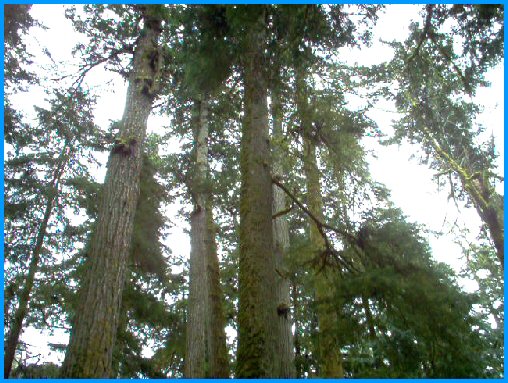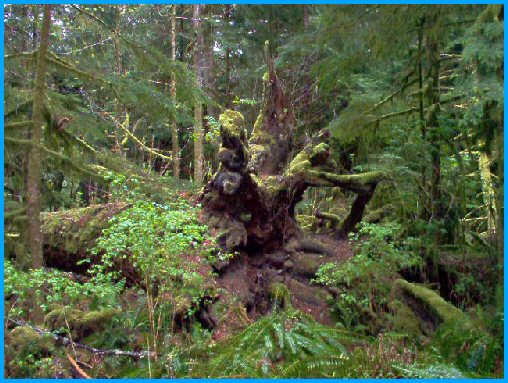|
Prose
The Political Economy of British Columbia's Rainforests
by Elmer G. Wiens
In The Intemperate Rainforest, Bruce Braun conceives environmentalism as the social production of physical nature as an artefact, and the social construction of nature as a concept (256). While ecology is a science of nature, environmentalism crucially makes value judgements about states of nature. Human beings live in nature, and continually modify nature. Nature incorporates culture, and continuously affects humans (257). Change characterizes how nature and culture operate and interact, making nature "an effect of culture (and power)" (258). Braun contends that "capitalism gives to nature its specific form" (256), and power determines nature and culture, historically (258).
Political economy provides a narrative structure within a historical-political framework to analyze how power operates through politics, markets, the public, and governments to create social nature. The analytics of political economy permit one to examine how and why society produces nature in specific manifestations. Moreover, political economy permits one to comment on why special interest groups desire a certain form of nature to obtain, physically and conceptually.
Aristotle developed his analytics of political economy in Politics and Ethics from concerns about the commutative justice or ethics of markets of exchange. In the History of Economic Analysis, Joseph Schumpeter states that the ethics of power—such as a monopoly—provide a strong motive to analyze market mechanisms, and how the state and society can ameliorate the effects of power through legislation and public administration (57-62). The institution of private property and the abolition of forced labour expanded the market sectors of economies. In the twentieth century, the ideology about public and private property culminated in the conflict between communist and capitalist countries. With the worldwide collapse of communism, economists debate the advantages and disadvantages of regulated versus laissez-faire capitalism. These issues of private and public property feature crucially in British Columbia's rainforest discourses.

|
The British Columbia government leases forests, owned collectively by citizens, to privately owned companies who log the timber for profit. Under this arrangement of private entitlements and public property, forest companies harvest vast tracts of B.C.'s forests, providing a stream of wealth for the government, forestry workers, companies and shareholders. Recently, First Nations peoples challenged the rights of these entities to B.C.'s forest wealth by reasserting their claims to aboriginal lands ostensibly owned by the government in right of the Crown. Environmental activists and non-governmental organizations (NGOs), such as the David Suzuki Foundation and Greenpeace, contested the type of nature the for-profit market place produces. Meanwhile, some forest industry spokespersons and analysts promote the privatization of B.C.'s forests, claiming that private property provides the correct incentives to maintain forests over the long run.
These competing claims and visions render the forests of B.C. into political spaces, which Joel Martineau describes as "cultural arenas in which stakeholders continually contest power and privileges." Forest companies annex the government's monopoly to B.C.'s forests, securing long-term tenures to timber at unreasonably favourable terms through lobbying and every conceivable legal stratagem. Forest workers' unions agitate politically through the left-wing New Democrat Party to ensure the Ministry of Forests supplies sufficient timber for stable employment. Environmental organizations campaign for the preservation of the wilderness of old-growth pre-logged forests. First Nations peoples fight for recognition of their rights, heritage, and culture integrated with nature. As political economy predicts, the government's monopoly of the forests intensifies the importance of political power as a factor in the exploitation and transformation of physical nature, and in the social construction of nature as concept.
The B.C. government charges forest companies a stumpage fee to cut timber from publicly owned forests. The stumpage rate and fees collected by the government reveal the extent to which forest companies and workers have taken over the B.C. government's forest monopoly. The Ministry of Forests computes stumpage fees as the residual obtained after deducting all costs, such as logging, transportation, and manufacturing, from the market value of a stand of timber's wood products. In the U.S.A., forest companies bid competitively for the right to harvest timber, resulting in market determined stumpage fees. American claims that B.C. subsidizes exports of softwood lumber turn on this difference in determining stumpage fees. Forest industry analysts estimate this subsidy to forest firms at $3 billion per year. Historically, political parties forming the B.C. government justified low stumpage rates as a means to create and maintain employment. However, market based stumpage fees would greatly reduce the scale and extent of logging in B.C. with profound, long-term effects on B.C.'s nature, forests, and culture.
Political economy predicts that a few entities with vested, concentrated interests and much to gain will take over a power nexus at the expense of many individuals with diffuse, scattered interests. In B.C. forest companies and forestry workers benefit, while First Nations peoples and the general public lose. Political economy also suggests that countervailing power may emerge within the political-market-public structure to offset monopoly power (Gailbraith 111). Increasingly, environmental NGOs counter the political hegemony of the forest industry with international media campaigns. Recently, the struggle between the forest industry and environmental organizations resulted in significant concessions in Clayoquot Sound and the Great Bear Rainforest. Though diverted to less contentious regions, forestry firms log at historically high levels throughout much of B.C. By building their constituencies of supporters, the environmental NGOs constrain and shape the legislated policies and public administration of the Ministry of Forests, and the logging activities of the forest industry (Braun 217).
Braun scrutinizes the efficacy of the NGOs' strategies distinguishing ancient rainforests from logged-over modified forests (225). British Columbia's old-growth forests, some in pre-logged pristine condition, contrast conspicuously with clearcuts denuded of trees. The Sierra Club's maps of Vancouver Island's disappearing forests based on satellite photographs fuelled "a global campaign" to save B.C.'s rainforests (222). The NGOs mingled these images with the traditional ecology of forests as interconnected webs of symbiotic organisms, self-regulating ecosystems adjusting to natural disturbances to achieve equilibrium of "order and balance" (228). Altogether, the environmental movement acquired a romantic tinge protecting pristine forests and wilderness from attack by devastating incursions from human culture external to nature. Braun problematizes wilderness as a myth, and warns of the possibly greater, overlooked environmental dangers of developments that expand into modified forests (224). While the NGOs' strategies greatly enhanced their countervailing power, Braun questions these strategies' efficacy in the future.

|
Modern ecology stresses human activity as internal to nature, and dynamic change in ecosystems instead of the equilibrium notions of traditional ecology. In Balancing Act, forestry ecologist Hamish Kimmins classifies logging and forest fires as examples of disturbance regimes. While the forest's ability to adapt to the disturbance matters, the source of the disturbance is immaterial. Moreover, changes in human societies often drive the changes in ecosystems (14). Without occasional disturbances, a forest's ecosystem may actually stagnate, and degenerate the forest's trees (24). Kimmins claims that how the forest ecosystem changes over time takes precedence over "the present condition of a particular forest ecosystem" (20). Although Kimmins emphasizes the difference between ecology and environmentalism, Braun sees these moves by forestry ecologists as attempts to enroll nature as an ally to perpetuate the capitalistic exploitation of B.C.'s forests. Braun asserts that rainforests "must be represented" (Braun 260). Conceptualizing forests as rainforests instead of stands of timber threatens the forest industry's hegemony. Apparently, forestry ecology and the forest industry exist symbiotically. Political economy confirms that industry interests will fight to maintain hegemony over nature and forests as physical and conceptual entities.
Braun argues that a world of dynamic change makes politics possible (267). Human flux generates the agency of politics. Politics and power enable the partial, uncertain, and intermittent management of change. Without change, "there would be no need for politics" (267). British Columbia's forest industry invested massively in such capital as plant, machinery, equipment, technology, and skilled workers. Capital intensity engenders a desire for political intensity. The forest industry's desire to commandeer political power persists unabated. Stakeholders in the industry co-opt politics and power, and manoeuvre to stabilize common sense truths about nature serving their interests (262). While these truths influence the politics of forestry, their factuality has no essence. In the past, these truths obtained through cognitive failures that erased First Nations peoples and ecological relations from nature (260). During the last two decades, the NGOs and First Nations peoples disrupted the forest industry-Ministry of Forests hegemony in B.C. The federal and provincial governments compromised by undertaking the Nisga'a, Clayoquot Sound, and Great Bear Rainforest agreements. In the meantime, environmentalists re-conceptualized their ecological theories (268). Political economy's dynamics shape nature's social construction as a concept and physical nature as an artefact.
Works Cited and Consulted
Braun, Bruce. The Intemperate Rainforest: Nature, Culture, and Power on Canada's West
Coast. Minneapolis: U Minnesota P, 2002.
Gailbraith, John K. American Capitalism: The Concept of Countervailing Power. Boston: Houghton Mifflin, 1952.
Kimmins, Hamish. Balancing Act: Environmental Issues in Forestry. Vancouver: UBC Press, 1992.
Schumpeter, Joseph. History of Economic Analysis. New York: Oxford UP, 1968.
|



















